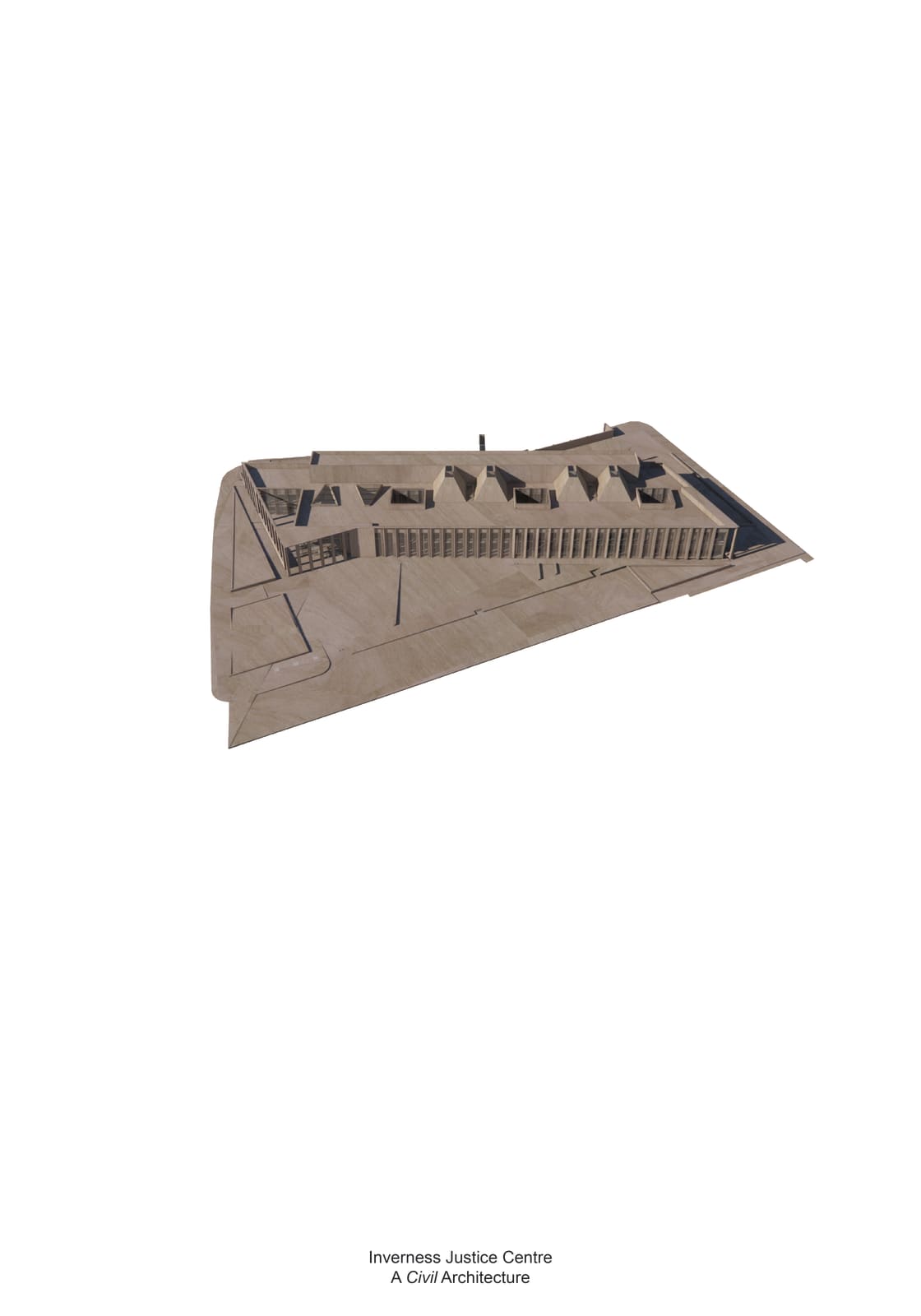Neil Gillespie RSA - Reiach and Hall
Inverness Justice Centre
Text, images of model and images of completed building
Towards a civil architecture Inverness Justice Centre is the first court complex in Scotland to bring together in one building all the organisations that administer and support the justice system,...
Towards a civil architecture
Inverness Justice Centre is the first court complex in Scotland to bring together in one building all the organisations that administer and support the justice system, services which include the Scottish Courts and Tribunals Service, the Crown Office and Procurator Fiscal Service, Families Outside, Criminal Justice Social Work, HMCTS (Social Security and Child Support Tribunal, Employment Tribunal), NHS Highland, Police Scotland, Scottish Women’s Aid, Witness Service/Victim Support and the Citizens Advice Bureau.
The building design attempts to support reforms currently being made to the justice system. Key amongst the reforms, which have a possibility in architectural design, are increased accessibility, legibility and visibility. These ambitions proved to be demanding. Aside from a restricted budget the most challenging issue was working within the strictures of traditional courtroom layouts with their long-established and limiting protocols. In addition to accessibility, legibility and visibility a fundamental objective of our architectural concept was the bringing daylight and natural ventilation to witness rooms, jury rooms and staff areas. Spaces, which are invariably poorly served in these complex and traditionally deep plan buildings.
The linear plan is defined by two parallel circulation spines over two levels. An east west route which aligns with the southern police station boundary is secure and private, serving sheriff chambers, SCTS and PFS, courtrooms and jury rooms while to the north lies a generous east west public route, serving the courtrooms, witness rooms and staff help areas. This public space looks out onto the new park. Spanning between the two main circulation spines lies a sequence of open landscaped courtyards, courtrooms, witness rooms and jury rooms. The design challenged the accepted deep planning of court building typologies. The courtyards not only organise and give form to the critical and complex separation of parties within the court process, they also realise our fundamental ambitions of creating a legible plan and bringing daylighting to all spaces.
The building projects a dignified and confident response to its marginal, edge of town location through the insistence of the repetitive rhythm to the main columnar façade along with the creation of a new landscaped park. Pedestrians are invited to walk through the park thereby opening up a formerly closed site. This park and pedestrian route anticipate the opening up of a new quarter to Inverness.
The building’s architectural language, while recognising its civic responsibility, attempts to avoid imposing an authoritarian will on the townscape, rather, through the buildings direct connection to the new park and the clear visibility that the main façade affords into and out of the building, the design suggests a civil architecture, a language which promotes inclusion and collaboration. The construction and material palette were stripped back to their essential components in pursuit of an elemental, austere and still expression. The criminal courtrooms are seen as the culmination of the architectural sequence. Timber lined courtrooms are orchestrated below a pyramidal roof forms, each courtroom is lit by a single clear rooflight. The heightened volume, the simple geometry and the elemental nature of the space serve to signify and amplify the gravity and solemnity of the court process.
Neil Gillespie OBE RSA
Team:
Reiach and Hall Architects (Project Architect Libby Heathcote)
Horner + Maclennan Landscape Architects
Arup Structural + MEP Engineers
Contractor Robertson Construction Ltd
Photography: Reiach and Hall Architects / Keith Hunter Photography
Inverness Justice Centre is the first court complex in Scotland to bring together in one building all the organisations that administer and support the justice system, services which include the Scottish Courts and Tribunals Service, the Crown Office and Procurator Fiscal Service, Families Outside, Criminal Justice Social Work, HMCTS (Social Security and Child Support Tribunal, Employment Tribunal), NHS Highland, Police Scotland, Scottish Women’s Aid, Witness Service/Victim Support and the Citizens Advice Bureau.
The building design attempts to support reforms currently being made to the justice system. Key amongst the reforms, which have a possibility in architectural design, are increased accessibility, legibility and visibility. These ambitions proved to be demanding. Aside from a restricted budget the most challenging issue was working within the strictures of traditional courtroom layouts with their long-established and limiting protocols. In addition to accessibility, legibility and visibility a fundamental objective of our architectural concept was the bringing daylight and natural ventilation to witness rooms, jury rooms and staff areas. Spaces, which are invariably poorly served in these complex and traditionally deep plan buildings.
The linear plan is defined by two parallel circulation spines over two levels. An east west route which aligns with the southern police station boundary is secure and private, serving sheriff chambers, SCTS and PFS, courtrooms and jury rooms while to the north lies a generous east west public route, serving the courtrooms, witness rooms and staff help areas. This public space looks out onto the new park. Spanning between the two main circulation spines lies a sequence of open landscaped courtyards, courtrooms, witness rooms and jury rooms. The design challenged the accepted deep planning of court building typologies. The courtyards not only organise and give form to the critical and complex separation of parties within the court process, they also realise our fundamental ambitions of creating a legible plan and bringing daylighting to all spaces.
The building projects a dignified and confident response to its marginal, edge of town location through the insistence of the repetitive rhythm to the main columnar façade along with the creation of a new landscaped park. Pedestrians are invited to walk through the park thereby opening up a formerly closed site. This park and pedestrian route anticipate the opening up of a new quarter to Inverness.
The building’s architectural language, while recognising its civic responsibility, attempts to avoid imposing an authoritarian will on the townscape, rather, through the buildings direct connection to the new park and the clear visibility that the main façade affords into and out of the building, the design suggests a civil architecture, a language which promotes inclusion and collaboration. The construction and material palette were stripped back to their essential components in pursuit of an elemental, austere and still expression. The criminal courtrooms are seen as the culmination of the architectural sequence. Timber lined courtrooms are orchestrated below a pyramidal roof forms, each courtroom is lit by a single clear rooflight. The heightened volume, the simple geometry and the elemental nature of the space serve to signify and amplify the gravity and solemnity of the court process.
Neil Gillespie OBE RSA
Team:
Reiach and Hall Architects (Project Architect Libby Heathcote)
Horner + Maclennan Landscape Architects
Arup Structural + MEP Engineers
Contractor Robertson Construction Ltd
Photography: Reiach and Hall Architects / Keith Hunter Photography

